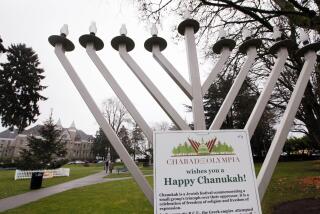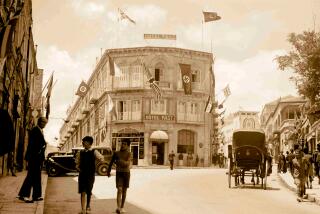Backyard Archeology : Israeli Gets to Know Centuries-Old Friend
- Share via
VERED HAGALIL, Israel — Sometimes, when the former Edward Stone of Chicago is as serene as the sun-bathed hills overlooking the north shore of the Sea of Galilee here, he can almost picture the man he calls “the neighbor.”
“I can see him from afar,” said the guest-ranch owner, who Hebraized his name to Yehuda Avni and settled here 25 years ago. “I can see his robes, and I can see his vehicles--I mean, he probably had some nice mules and donkeys. But the rest is a problem.”
A quarter-century might seem adequate to get to know the man next door more intimately than that. But Avni’s “neighbor” is special: He’s been dead for nearly 2,000 years.
Wine Press, Ancient Coin
Avni has learned about him painstakingly, through the clues the “neighbor” left behind: his stone wine press, an ancient coin he dropped, a hole in the earth he used to store water, pieces of the columns he used to build his house and the pottery from which he ate and drank.
The story of Yehuda Avni and his neighbor is one that may be unique to Israel, a country so rich in history that archeological discoveries which would be national treasures elsewhere can remain virtually the personal preserve of one man.
“There’s so many other things to dig in Israel that (the authorities) say if somebody really wants to do it by themselves, let them go ahead,” Avni said with a shrug.
Discharged from the U.S. Army after World War II, Avni--then Stone--returned to Europe to study at the University of Geneva. Later, he volunteered to fight in the 1948-1949 Arab-Jewish conflict that gave birth to the state of Israel.
Lived on Kibbutz
By the time he could get here, the war was over. But Avni, then 25, liked what he saw and decided to stay. He lived on a kibbutz for several years, and then, in 1960, came to the Galilee with his wife, Yona, to begin building their ranch, which has since become a favorite vacation spot for foreign and Israeli tourists alike.
Avni loved horses and roses, so he stocked his ranch with both and called it Vered Hagalil, “Rose of the Galilee.”
When they needed a break from the strenuous work of building their new home, the Avnis would visit the hill across the road to enjoy the breathtaking view of the Sea of Galilee.
“When we started here, I was very nervous because we didn’t have any money,” recalled Yona Avni. “But when I went and sat on this hill, all my worry disappeared.”
Noticing Patterns
It wasn’t until the early 1960s that they noticed that the rocks on which they often sat to eat their lunch seemed to be arranged in a pattern. “Then we realized we were sitting on something that had been put together by somebody a long time ago,” Avni said.
He has been digging on the hill in his spare time ever since. His mental picture of his ancient neighbor results from the things he has discovered, the occasional help and advice of some amateur archeologist friends and his own deepening knowledge of the history of this area.
The rocks turned out to be part of an ancient stone wine press, with one pit for crushing the grapes and two deeper pits for the wine to settle and ferment.
“This would go back to the first man who lived here--to our neighbor,” Avni said.
Six-Pointed Mark
There are three possible explanations for a six-pointed mark resembling a Star of David carved into the wall of the wine press, Avni speculated. It could be a mark attesting that his neighbor’s wine was kosher and thus could be used in the temple, or a sign that he had paid his taxes or an accident of geology.
“I think it’s that his wine was usable for the temple,” Avni said.
One of his archeologist friends made a sketch of what the press must have looked like when in use, and Avni sent it to Charles Heidsieck, an English champagne company, for an expert opinion.
The company replied: “The curious thing about this press is that it is somewhat different from the open vat in which the workmen used to jump about. The point of interest is that the result must have been excellent, as only the better part of the must, which is in the softer part of the grapes, was pressed.”
Ancient Mortar
Both the settling pit of the wine press and a nearby underground water cistern are lined with a mortar that scientific analysis proved to be made from washed sand, ground-up pottery, olive oil, and water. “This type of mortar was in use at that time--100, 200, 300 BC,” Avni noted.
Avni also found a tiny coin near the press, with minting scientifically dated to sometime between 67 and 40 BC.
A few yards away, Avni found the remains of a house and stables. Portions of three large pillars which presumably decorated the broad front of the residence and heavy tile stones from the floor attest to the affluence of Avni’s neighbor. The fact that the house commanded a superb view of the Sea of Galilee shows he “had a sense of aesthetics,” Avni added.
The ranch owner assumes that his ancient predecessor was Jewish (“we know that there were more Jews living in the Galilee then than there are now”) and that he had a family (“the man couldn’t do all that work by himself!”).
Bonfires on the Hills
“He could be contacted by Jerusalem (more than 100 miles south) faster sometimes than I can today,” Avni said. His neighbor’s house was on a line of hills used by the priests 2,000 years ago for bonfires signaling the beginning and end of holidays and sacrificial days, Avni explained. “This place is seven bonfires away from Jerusalem.”
The nearest town was Korazim, a place Jesus once called worse than Sodom and Gomorrah, the evil biblical cities on which God is said to have rained fire and brimstone.
Someday, Avni still hopes, he will learn the exact identity of the man who once lived next door. “We know that wine jugs carried the name of the person who made them,” he said.
Avni also hopes one day to restore the old wine press, using his own money and donations that guests at his ranch have started to set aside--”rather that than put (the money) into a tennis court,” he said.
He has already erected a bench-swing over the area where the house next door once stood. How does he feel as he sits there?
“Say you had gone back and found the house where your great-great-grandfather was born. Wouldn’t that give you a nice feeling? That’s the way I feel.”
More to Read
Sign up for Essential California
The most important California stories and recommendations in your inbox every morning.
You may occasionally receive promotional content from the Los Angeles Times.












